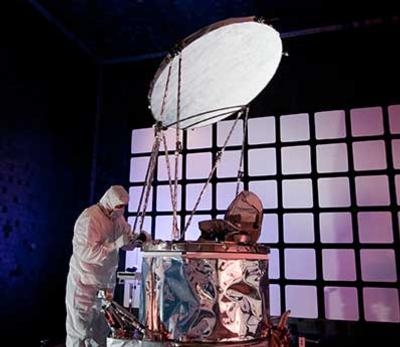Mon, Dec 04, 2017
Will Provide Next-Gen Weather Satellite
The U.S. Air Force Space and Missile Systems Center (SMC) has selected Ball Aerospace to deliver the next-generation operational environmental satellite system, Weather System Follow-on – Microwave (WSF-M), for the Department of Defense (DoD). WSF-M is a predominantly fixed price contract that will provide for system design and risk reduction of a Low Earth Orbit (LEO) satellite with a passive microwave imaging radiometer instrument and hosted Government furnished energetic charged particle (ECP) sensor. The contract will include options for the development and fabrication of two LEO satellites as well as options for launch vehicle integration, launch and early orbit test, and operational test and evaluation support. This mission will improve weather forecasting over maritime regions by taking global measurements of the atmosphere and ocean surface.

"This is an exciting win for us, and we're looking forward to expanding our work with the Air Force and continuing to support warfighters and allies around the world," said Rob Strain, president, Ball Aerospace. "WSF-M extends Ball's legacy of providing precise measurements from space to enable more accurate weather forecasting."
As the prime contractor, Ball will be responsible for developing and integrating the entire microwave system, which includes the microwave instrument, spacecraft and system software.
WSF-M is designed to mitigate three high priority DoD Space-Based Environmental Monitoring (SBEM) gaps: ocean surface vector winds, tropical cyclone intensity and LEO energetic charged particles.
This new environmental satellite system leverages the Ball-built Global Precipitation Measurement (GPM) Microwave Imager (GMI) instrument, which is the on-orbit reference standard for calibrating precipitation measurements in NASA's GPM constellation. The WSF-M bus will be based on the Ball Configurable Platform, a proven, agile spacecraft with 50 years of on-orbit operations for affordable remote sensing applications.
Ball has played key roles on numerous national and international programs that make critical measurements of the physical environment. These include designing and building the weather spacecraft for both the recently launched Joint Polar Satellite System-1 (JPSS-1) and for the Suomi National Polar-orbiting Partnership (Suomi NPP).
(Source: Ball Aerospace news release. Image of GMI instrument provided)
More News
Aero Linx: Model Aeronautical Association of Australia MAAA clubs are about fun flying, camaraderie and community. For over 75 years, the MAAA has been Australia’s largest fl>[...]
Touchdown Zone Lighting Two rows of transverse light bars located symmetrically about the runway centerline normally at 100 foot intervals. The basic system extends 3,000 feet alon>[...]
“Discovery and innovation are central to our mission at Virgin Galactic. We’re excited to build on our successful record of facilitating scientific experiments in subor>[...]
How To Get A Story On Aero-TV News/Feature Programming How do I submit a story idea or lead to Aero-TV? If you would like to submit a story idea or lead, please contact Jim Campbel>[...]
Student Pilot Reported That During Rotation, “All Of A Sudden The Back Of The Plane Kicked To The Right..." Analysis: The student pilot reported that during rotation, “>[...]
 ANN's Daily Aero-Linx (05.02.24)
ANN's Daily Aero-Linx (05.02.24) ANN's Daily Aero-Term (05.02.24): Touchdown Zone Lighting
ANN's Daily Aero-Term (05.02.24): Touchdown Zone Lighting Aero-News: Quote of the Day (05.02.24)
Aero-News: Quote of the Day (05.02.24) ANN FAQ: Contributing To Aero-TV
ANN FAQ: Contributing To Aero-TV NTSB Final Report: Cirrus Design Corp SR20
NTSB Final Report: Cirrus Design Corp SR20



